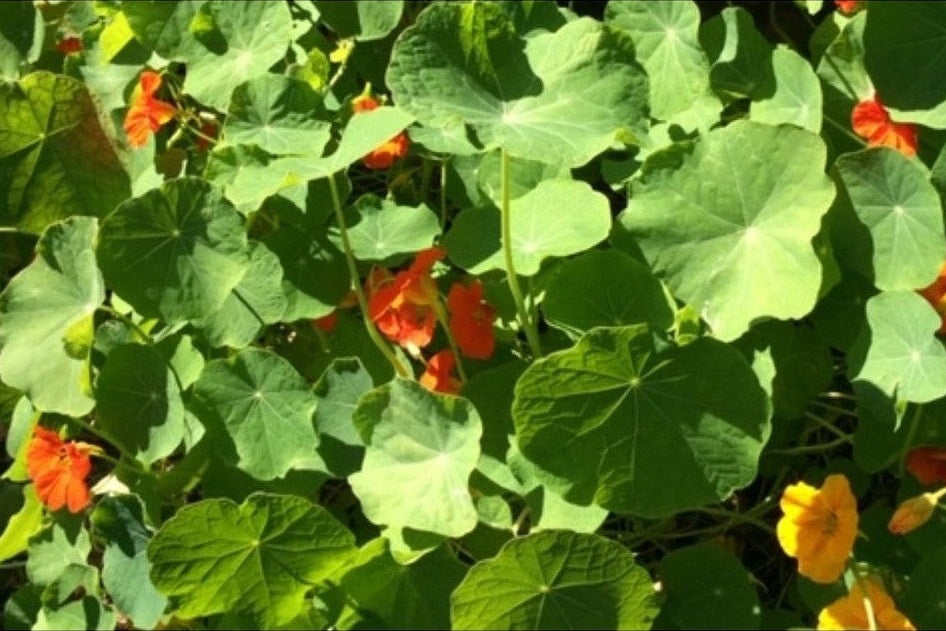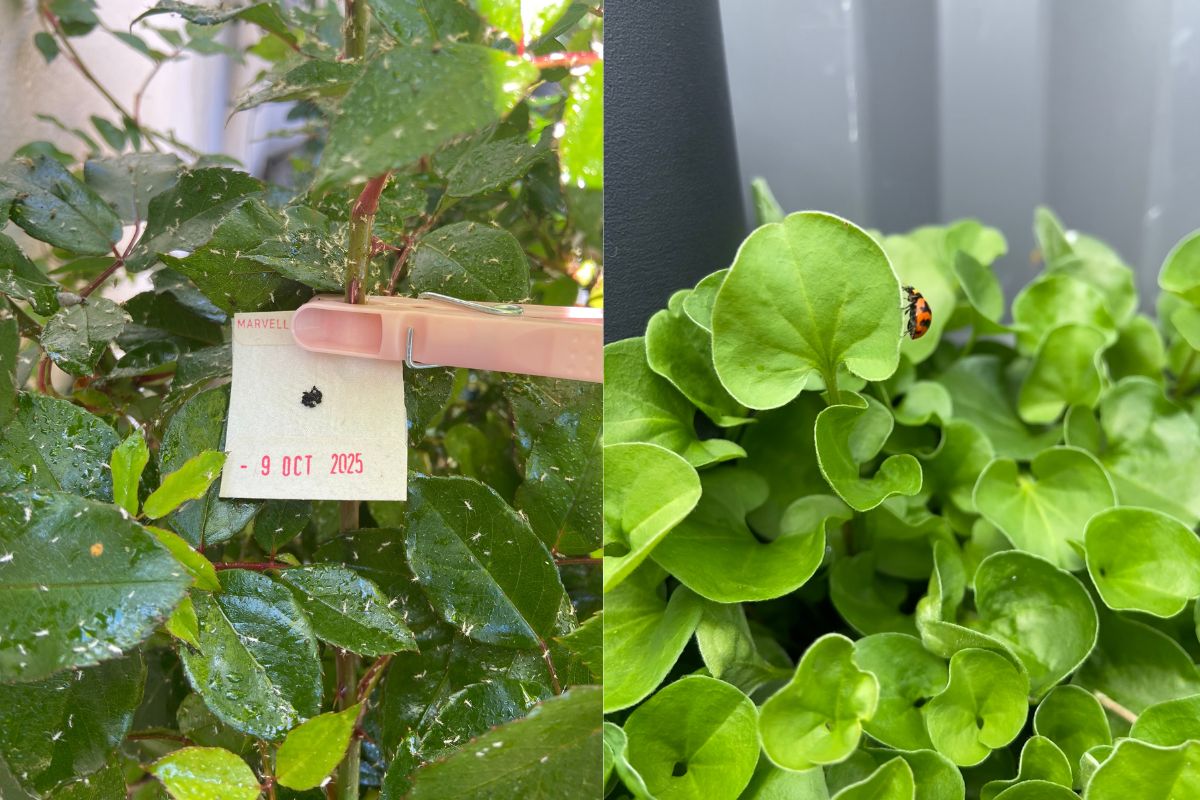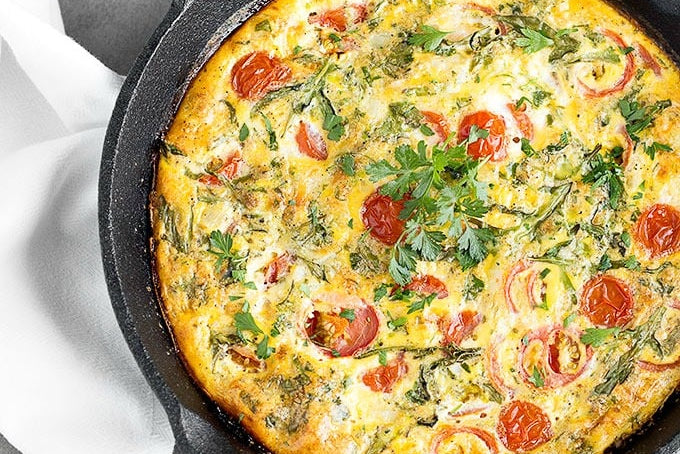The end of Spring is a great time for sowing a huge range of seeds. Scroll down to see a guide of Seeds to Sow Now, but first we'd love to tell you about something a bit different you can do in your garden at this time of year.
The Many Uses of Nasturtiums
Nasturtiums are a surprisingly beneficial plant to have in your garden. Not only do their bright flowers lighten a space, but they also attract pollinators and beneficial insects, provide ground cover and prevent invasive weeds from taking over. They prefer poor soil so are easy to grow and are very easy to pull out if you decide you want the space for something else. They are a great companion to most plants in your garden.
Were you aware that nasturtiums are also edible? You can eat every part of the plant; from it's leaves which can be chopped into salads, to the gorgeous edible flowers. What we'd love to show you in this article is how you can turn nasturtium seeds into capers!


Nasturtium seed pods develop at the end of the plant's season: right about now at the end of Spring. The flowers start to die off and leave in their place three little green pods that, when pickled, look and taste surprisingly like capers! You can easily pick lots of these little pods and turn them into an inexpensive and delicious food.
Get out there and make the most of your handy nasturtiums! Be sure to leave some of the pods to dry out and self-seed for next season.
Nasturtium Caper Recipe
This recipe has come from our friends at Pip Permaculture Magazine. You can see their full blog here.
To make one small jar of nasturtium capers you will need:
- 1/2 cup green nasturtium seeds
- 2 tsp salt
- 2 cups water
- 2 tsp sugar
- 3/4 cup white vinegar
Method:
- Rinse the nasturtium seeds and place them in a jar.
- Make a brine solution with 1 cup of water and 1 tsp salt and pour this over the seeds. Place the lid on the jar and let it sit at room temperature for 24 hours.
- Drain and rinse the seeds and repeat step 2, letting them sit for another 24 hours in brine.
- Drain and rise the seeds well and place them in a sterilized jar.
- Mix together the vinegar and sugar in a saucepan and bring them to the boil. Pour this liquid over the nasturtium seeds, ensuring they are all covered, and allow to cool. You may wish to add spices and herbs to the vinegar solution such as peppercorns, bay leaves, thyme or whatever takes your fancy.
- Once cooled to room temperature, place the lid on the jar and your capers are ready! Refrigerate after opening and they will store in the fridge for at least 6 months.
Use these nasturtium capers just as you would traditional capers, adding a tangy burst of flavour to any dish. Enjoy!
Seeds to Sow Now
Plant |
How to Sow |
Germination Time |
Time Until Harvest |
Other Tips |
|
Amaranth |
Sow directly into garden bed Sept-Mar |
8-10 days |
26 weeks |
Grow in fertile, well drained soil |
|
Basil |
Sow into a seedling flat as soon as night time temperature is above 10degC in September |
5-15 days |
10-12 weeks |
Pinch off new shoots and flowers to encourage bushy growth. Plant near tomatoes to improve growth and flavour |
|
Dwarf Beans |
Sow directly into the garden or into biodegradable pots Aug-Feb. Needs warm soil |
7-13 days |
8-12 weeks |
Plant near celery or cucumber |
|
Beetroot |
Sow directly into the garden or in seedling flats at any time |
7-14 days |
10-12 weeks |
Add leaves for a sweet and earthy note in salads |
|
Borage |
Sow directly into garden Sept-Nov and only lightly sprinkle with soil. Biennial plant |
5-10 days |
Harvest leaves and flowers as needed |
Attracts beneficial insects & bees. Plant with tomatoes, squash, and strawberries |
|
Burdock |
Sow directly into garden Sept-Apr |
4-7 days |
17-18 weeks |
Cook young leaves like spinach and harvest root when young |
|
Capsicum |
Best sown in a seedling flat in warm weather Sept-Nov |
7-14 days |
10-16 weeks |
Keep well watered when fruiting |
|
Carrot |
Sow directly into the garden Aug-May and only lightly sprinkle with soil as they need light to germinate |
14-21 days |
12-16 weeks |
Water seedlings well |
|
Celery |
Best sown in a seedling flat and then transplant into garden |
10-21 days |
12-18 weeks |
Plant near dill but away from beans and tomatoes |
|
Chillies |
Sow in a seedling flat or tray and plant out in 6 weeks |
7-14 days |
2-5 months |
Semi-perennial plants |
|
Corn |
Sow only 20-30cm apart to enhance pollination |
6-10 days |
11-14 weeks |
Grow with beans and pumpkin - the Three Sisters. Don't over water seeds after first water |
|
Cucumber |
Sow directly into garden or in biodegradable pots when weather gets warm, Sept-Mar. Cover with soil |
5-10 days |
8-12 weeks |
Increase watering when fruiting. Beware of mould if overwatered or high levels of humidity |
|
Dill |
Sow directly into the garden Sept-Nov |
7-15 days |
8-12 weeks |
Plant near celery but away from beans and tomatoes. Fabulous IPM plant |
|
Eggplant |
Best sown in a seedling flat Sept-Nov. Lightly sprinkle with soil |
7-14 days |
16-18 weeks |
Loves the heat |
|
Endive |
Sow directly into the garden Aug-Nov |
10-14 days |
8-12 weeks |
Salad vegetable with peppery taste |
|
Jerusalem Artichoke |
Sow directly into garden bed |
5-10 days |
15-20 weeks |
Produces many tubers, easy to grow and can handle many soil types |
|
Lettuce |
Sow into seedling flats all year round |
4-14 days |
6-12 weeks |
Pick Cos lettuce leaves as growing. Transplant into part shade in summer. |
|
Lemon Balm |
Sow directly into the garden Oct-Nov |
12-21 days |
8-10 weeks |
Great as a culinary herb and for Integrated Pest Management (IPM) |
|
Melons |
Sow directly into garden bed Sept-Feb |
7-14 days |
14-16 weeks |
Needs warm weather. |
|
Okra |
Sow directly into garden bed Oct to Nov and transplant into garden bed Dec to Jan |
8-13 days |
11-14 weeks |
Grow with capsicum, chilli and eggplant. Pick pods while young. Edible flowers. |
|
Pumpkin & Squash |
Sow directly into garden Aug-Oct |
6-10 days |
14-16 weeks |
Need lots of space. Good companion with corn |
|
Tomatoes |
Sow in a seedling flat or directly into a garden bed Nov -Dec |
7-14 days |
12-20 weeks |
Plant near Basil and Marigolds for integrated pest management. Allow good airflow to reduce disease potential |
|
Zucchini |
Sow direct into garden beds Sept to Dec. |
5-10 days |
8-14 weeks |
Avoid watering leaves as this can increase mould and reduce fruiting |
If you haven't seen it already, take a look at our November Newsletter 2019: Plant Feature on corn to find out how to grow your own Three Sisters Garden - one of the oldest examples of companion planting. Now is the perfect time to start your three sisters growing!







Leave a comment (all fields required)